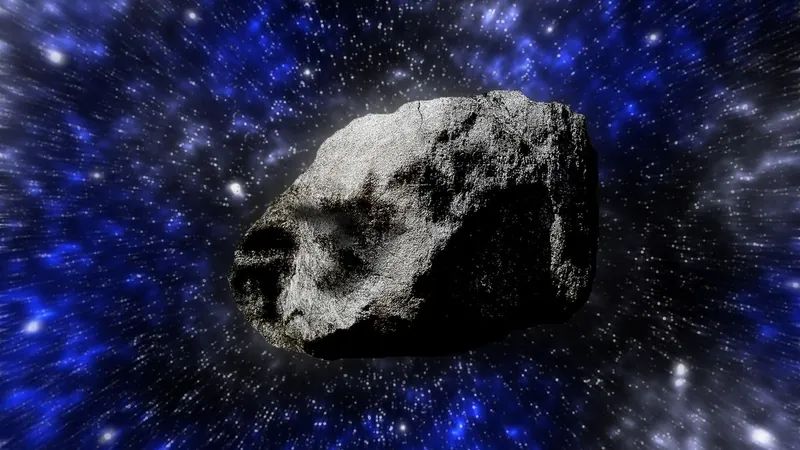
Asteroid 'God of Chaos' Set for a Transformative Encounter with Earth in 2029!
2024-11-03
Author: Li
Asteroid 'God of Chaos' Set for a Transformative Encounter with Earth in 2029!
A fascinating new study reveals that the asteroid Apophis, ominously tagged as the 'God of Chaos,' could undergo significant transformations during its close pass by Earth in 2029, thanks to tremors and landslides triggered by our planet's gravitational pull.
Stretching approximately 1,100 feet (340 meters) long, Apophis resembles a giant peanut hurtling through space. While an asteroid of this size would not pose an existential threat to Earth, it certainly has the potential to obliterate a city if it were to collide with our planet.
Discovered in 2004, Apophis initially raised alarm bells among astronomers due to the calculations suggesting a possible close encounter with Earth in 2029. However, recent observations made in 2021 enabled scientists to refine its trajectory, revealing that it has a significantly reduced likelihood of impacting Earth. Currently, the asteroid is expected to come as close as 20,000 miles (32,000 kilometers) to our planet on April 13, 2029 — a distance closer than many artificial satellites orbiting Earth!
Although this upcoming event won't likely harm us, scientists are now turning their attention to how Apophis itself may be affected. Ronald-Louis Ballouz, an asteroid scientist at the Johns Hopkins University Applied Physics Laboratory, expressed his curiosity regarding the surface changes that may occur when the asteroid approaches Earth. He noted that asteroids like Apophis experience ongoing bombardment from tiny meteoroids, a process referred to as space weathering. Yet, asteroids that swing close to Earth tend to display less weathered surfaces than expected — a phenomenon that scientists are eager to understand.
To delve deeper, Ballouz and an international team of researchers created computational models simulating Apophis's surface dynamics. Lacking comprehensive data on the asteroid, they based their models on the two-lobed asteroid Itokawa, which has been thoroughly studied. The simulations projected both large and small-scale changes to the asteroid's structure as it nears Earth.
The study identified two key processes that could alter Apophis's surface during the 2029 flyby. First, it is predicted that tremors will commence shortly before Apophis reaches its closest point to Earth, lasting briefly afterward. Although challenging to quantify, these tremors may be strong enough to dislodge boulders on the asteroid, creating patterns that could be detected by future spacecraft.
Second, Apophis's peculiar tumbling motion — akin to a poorly thrown football — may also induce changes. A recent study indicated that Earth's gravity could influence Apophis's rotation rate, either speeding it up or slowing it down. The new simulations corroborated this finding, indicating that these rotational changes could destabilize the rocky slopes on Apophis, potentially leading to gradual landslides over thousands of years.
These insights are monumental, as they offer a new perspective on how close planetary encounters can fundamentally reshape the surfaces of these small celestial bodies. The researchers are optimistic that NASA's upcoming OSIRIS-APEX mission will validate their theories. This repurposed spacecraft, originally designed for the OSIRIS-REx mission that collected samples from the asteroid Bennu, is slated for an 18-month study of Apophis following its 2029 encounter, aiming to examine its composition and map its surface features.
As we prepare for this remarkable cosmic event, one can only ponder: What other secrets does the 'God of Chaos' hold? Stay tuned!



 Brasil (PT)
Brasil (PT)
 Canada (EN)
Canada (EN)
 Chile (ES)
Chile (ES)
 Česko (CS)
Česko (CS)
 대한민국 (KO)
대한민국 (KO)
 España (ES)
España (ES)
 France (FR)
France (FR)
 Hong Kong (EN)
Hong Kong (EN)
 Italia (IT)
Italia (IT)
 日本 (JA)
日本 (JA)
 Magyarország (HU)
Magyarország (HU)
 Norge (NO)
Norge (NO)
 Polska (PL)
Polska (PL)
 Schweiz (DE)
Schweiz (DE)
 Singapore (EN)
Singapore (EN)
 Sverige (SV)
Sverige (SV)
 Suomi (FI)
Suomi (FI)
 Türkiye (TR)
Türkiye (TR)
 الإمارات العربية المتحدة (AR)
الإمارات العربية المتحدة (AR)